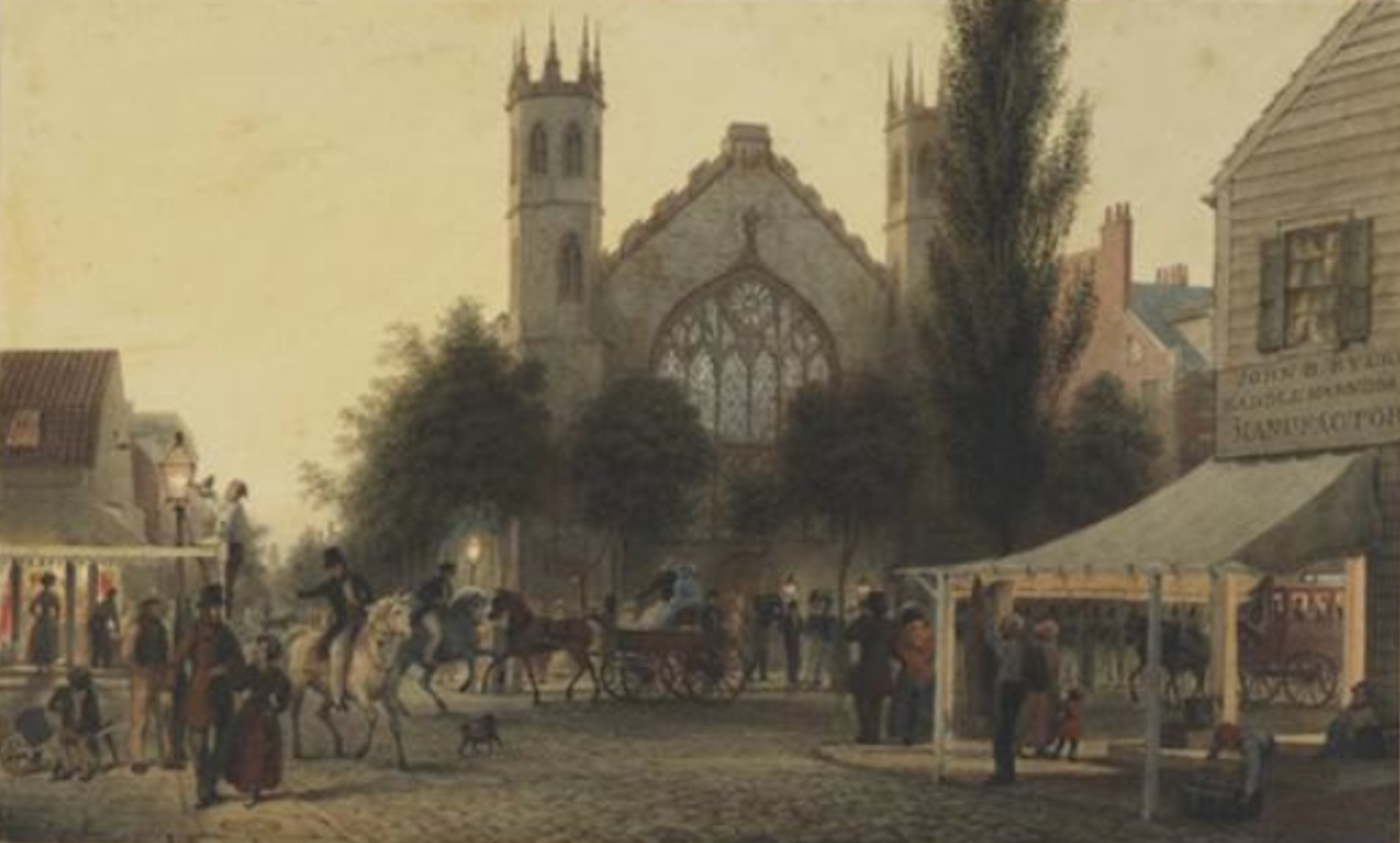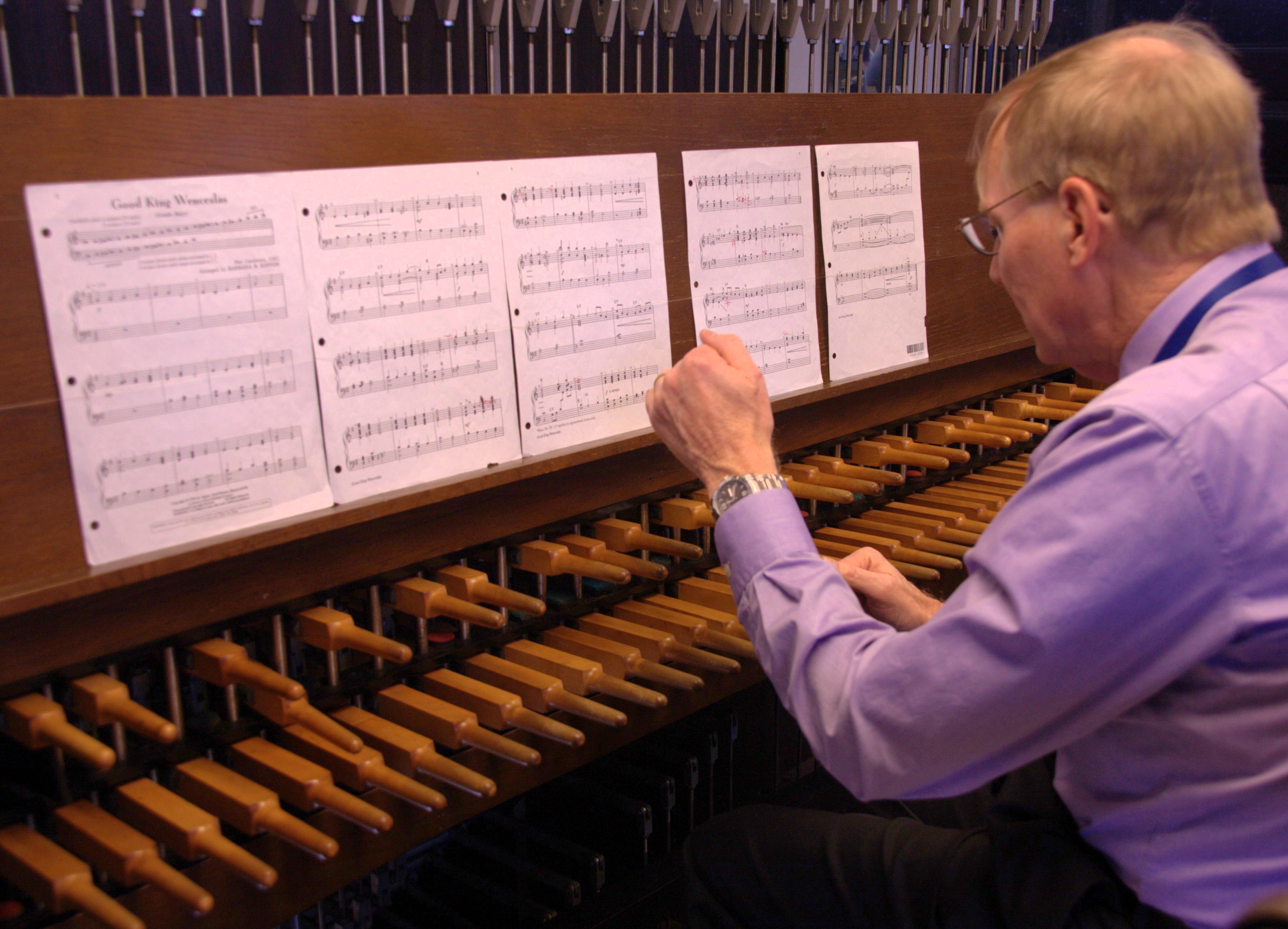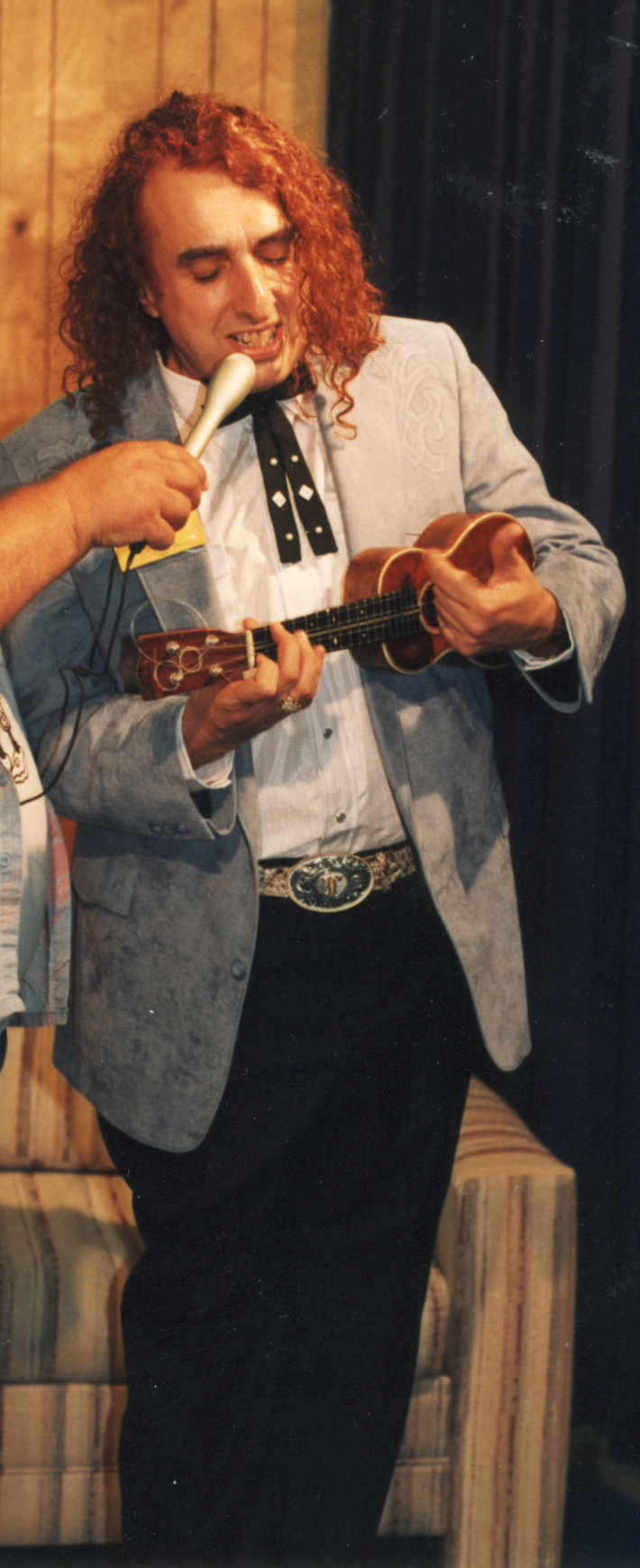|
Charlemagne Palestine
Chaim Moshe Tzadik Palestine (born August 15, 1947), known professionally as Charlemagne Palestine, is an American visual artist and musician. He has been described as being one of the founders of New York school of minimalist music, first initiated by La Monte Young, Terry Riley, Philip Glass, Steve Reich, and Phil Niblock, although he prefers to call himself a maximalist. Formational years Born in Brooklyn, New York, Palestine began by singing sacred Jewish music and studying accordion and piano. At the age of 12 he started playing backup conga and bongo drum for Allen Ginsberg, Gregory Corso, Kenneth Anger, and Tiny Tim (musician), Tiny Tim. From 1962 to 1969, Palestine was carillonneur for the Saint Thomas Church (Manhattan), Saint Thomas Episcopal Church in Manhattan, eventually creating a piece that consisted of 1,500 15-minute performances. From 1968 to 1972, Palestine studied vocal interpretation with Pran Nath (musician), Pandit Pran Nath, experimented on kinetic light s ... [...More Info...] [...Related Items...] OR: [Wikipedia] [Google] [Baidu] |
De Appel
De Appel is a contemporary arts centre, located in Amsterdam. Since it was founded in 1975 by , the goal of De Appel is to function as a stage for research and presentation of visual arts. Exhibitions, publications and discursive events are the main activities of De Appel. In 1994, Saskia Bos established an intensive course, called 'The Curatorial Programme'. Over a period of eight months a selective group of five to six people are trained to become a curator. At the end of 2012, former director Ann Demeester initiated a new professional development programme in collaboration with The Fair Gallery: the Gallerist programme. This programme was the first practice-oriented educational course for (aspiring) gallery owners and (young) art professionals who wanted to deepen their curatorial and business competencies in the commercial segment of the art world. In 2023 Lara Khaldi was appointed director. Former directors * Ann Demeester * Monika Szewczyk [...More Info...] [...Related Items...] OR: [Wikipedia] [Google] [Baidu] |
Philip Glass
Philip Glass (born January 31, 1937) is an American composer and pianist. He is widely regarded as one of the most influential composers of the late 20th century. Glass's work has been associated with minimal music, minimalism, being built up from repetitive Phrase (music), phrases and shifting layers. He described himself as a composer of "music with repetitive structures", which he has helped to evolve stylistically. Glass founded the Philip Glass Ensemble in 1968. He has written 15 operas, numerous chamber operas and musical theatre works, 14 symphony, symphonies, 12 concertos, nine string quartets, various other chamber music pieces, and many film scores. He has received nominations for four Grammy Awards, including two for Grammy Award for Best Contemporary Classical Composition, Best Contemporary Classical Composition for ''Satyagraha (opera), Satyagraha'' (1987) and ''String Quartet No. 2 (Glass), String Quartet No. 2'' (1988). He has received three Academy Award for Best ... [...More Info...] [...Related Items...] OR: [Wikipedia] [Google] [Baidu] |
Saint Thomas Church (Manhattan)
Saint Thomas Church is an Episcopal parish church of the Episcopal Diocese of New York at 53rd Street and Fifth Avenue in Midtown Manhattan, New York City. Also known as Saint Thomas Church Fifth Avenue or Saint Thomas Church in the City of New York, the parish was incorporated on January 9, 1824. The current structure, the congregation's fourth church, was designed by the architects Ralph Adams Cram and Bertram Grosvenor Goodhue in the French High Gothic Revival style and completed in 1914. In 2021, it reported 2,852 members, average in-person attendance of 224 (due to pandemic restrictions) and $1,152,588 in plate and pledge income. In 2020, following a gift from the family trust of the late John and Mary Alyce Merrow, a camera system with a dozen 360-degree-rotating cameras was installed. Online attendance has remained significant; during Advent and Christmas, 2022, on-line participation was 38,000 with an average attendance of 25 minutes. The church is home to the S ... [...More Info...] [...Related Items...] OR: [Wikipedia] [Google] [Baidu] |
Carillonneur
A carillon ( , ) is a pitched percussion instrument that is played with a musical keyboard, keyboard and consists of at least 23 bells. The bells are Bellfounding, cast in Bell metal, bronze, hung in fixed suspension, and Musical tuning, tuned in Chromatic scale, chromatic order so that they can be sounded harmoniously together. They are struck with clappers connected to a keyboard of wooden batons played with the hands and Pedal keyboard, pedals played with the feet. Often housed in bell towers, carillons are usually owned by churches, universities, or municipalities. They can include an automatic system through which the time is announced and simple tunes are played throughout the day. Carillons come in many designs, weights, sizes, and sounds. They are among the world's heaviest instruments, and the heaviest carillon weighs over . Most weigh between . To be considered a carillon, a minimum of 23 bells are needed; otherwise, it is called a chime (bell instrument), chime. S ... [...More Info...] [...Related Items...] OR: [Wikipedia] [Google] [Baidu] |
Tiny Tim (musician)
Herbert Butros KhauryTiny Tim: Tiptoe Through A Lifetime', Lowell Tarling, Generation Books, 2013, p. 29, (April 12, 1932 November 30, 1996), also known as Herbert Buckingham Khaury, and known professionally as Tiny Tim, was an American musician and musical archivist. He is especially known for his 1968 hit recording of "Tiptoe Through the Tulips", a cover of the popular song "Tiptoe Through the Tulips with Me" from the 1929 musical '' Gold Diggers of Broadway''. Tiny Tim was renowned for his wide vocal range, in particular his far-reaching falsetto. Life and career Early years Tiny Tim was born Herbert Khaury in Manhattan, New York City, on April 12, 1932. His mother Tillie (), a Polish-Jewish garment worker, was the daughter of a rabbi. She had immigrated from Brest-Litovsk, present-day Belarus, as a teen in 1914. His father, Butros Khaury, was a textile worker from Beirut, present-day Lebanon, and the son of a Maronite Catholic priest. Tiny Tim himself was a devout Catho ... [...More Info...] [...Related Items...] OR: [Wikipedia] [Google] [Baidu] |
Kenneth Anger
Kenneth Anger (born Kenneth Wilbur Anglemyer, February 3, 1927 – May 11, 2023) was an American Underground film, underground experimental filmmaker, actor, and writer. Working exclusively in short films, he produced almost 40 works beginning in 1937, nine of which have been grouped together as the "Magick Lantern Cycle". Anger's films variously merge surrealism with homoeroticism and the occult, and have been described as containing "elements of erotica, documentary, psychodrama, and spectacle".The Kinsey Institute''Spotlight on the Collections: Filmmaker Kenneth Anger'' 2004. Retrieved June 1, 2010. He has been called "one of America's first openly gay filmmakers", with several films released before LGBT rights in the United States, homosexuality was legalized in the U.S. Anger also explored occult themes in many of his films; he was fascinated by the English occultist Aleister Crowley and an adherent of Thelema, the religion Crowley founded. Anger was born into a middle-class ... [...More Info...] [...Related Items...] OR: [Wikipedia] [Google] [Baidu] |
Gregory Corso
Gregory Nunzio Corso (March 26, 1930 – January 17, 2001) was an American poet. Along with Jack Kerouac, Allen Ginsberg, and William S. Burroughs, he was part of the Beat Generation, as well as one of its youngest members. Early life Born Nunzio Corso at New York City's St. Vincent's Hospital, Corso later selected the name "Gregory" as a confirmation name.David S. Wills"The Life of Gregory Corso" ''Beatdom'', January 13, 2008. Within Little Italy and its community he was "Nunzio," while he dealt with others as "Gregory." He often would use "Nunzio" as short for "Annunziato," the announcing angel Gabriel, hence a poet. Corso identified with not only Gabriel but also Hermes, the divine messenger. Corso's mother, Michelina Corso (born Colonna), was born in Miglianico, Abruzzo, Italy, and immigrated to the United States at the age of nine, with her mother and four other sisters. At 16, she married Sam Corso, a first-generation Italian American, also teenage, and gave birth to ... [...More Info...] [...Related Items...] OR: [Wikipedia] [Google] [Baidu] |
Allen Ginsberg
Irwin Allen Ginsberg (; June 3, 1926 – April 5, 1997) was an American poet and writer. As a student at Columbia University in the 1940s, he began friendships with Lucien Carr, William S. Burroughs and Jack Kerouac, forming the core of the Beat Generation. He vigorously opposed militarism, economic materialism, and sexual repression, and he embodied various aspects of this counterculture with his views on drugs, sex, multiculturalism, hostility to bureaucracy, and openness to Eastern religions. Best known for his poem " Howl", Ginsberg denounced what he saw as the destructive forces of capitalism and conformity in the United States. San Francisco police and US Customs seized copies of "Howl" in 1956, and a subsequent obscenity trial in 1957 attracted widespread publicity due to the poem's language and descriptions of heterosexual and homosexual sex at a time when sodomy laws made male homosexual acts a crime in every state. The poem reflected Ginsberg's own sexuality a ... [...More Info...] [...Related Items...] OR: [Wikipedia] [Google] [Baidu] |
Bongo Drum
Bongos ( Spanish: ''bongó'') are an Afro-Cuban percussion instrument consisting of a pair of small open bottomed hand drums of different sizes. The pair consists of the larger ''hembra'' () and the smaller ''macho'' (), which are joined by a wooden bridge. They are played with both hands and usually held between the legs, although in some cases, as in classical music, they may be played with sticks or mounted on stands. Bongos are mainly employed in the rhythm section of son cubano and salsa ensembles, often alongside other drums such as the larger congas and the stick-struck timbales. In these groups, the bongo player is known as ''bongosero'' and often plays a continuous eight-stroke pattern called ''martillo'' () as well as more rhythmically free parts, providing improvisatory flourishes and rhythmic counterpoint. Bongos originated in eastern Cuba at the end of the 19th century, possibly from a pair of larger drums such as the bokú. These older, larger bongos are known ... [...More Info...] [...Related Items...] OR: [Wikipedia] [Google] [Baidu] |
Conga
The conga, also known as tumbadora, is a tall, narrow, single-headed drum from Cuba. Congas are staved like barrels and classified into three types: quinto (lead drum, highest), tres dos or tres golpes (middle), and tumba or salidor (lowest). Congas were originally used in Afro-Cuban music genres such as conga (hence their name) and rumba, where each drummer would play a single drum. Following numerous innovations in conga drumming and construction during the mid-20th century, as well as its internationalization, it became increasingly common for drummers to play two or three drums. Congas have become a popular instrument in many forms of Latin music such as son (when played by conjuntos), descarga, Afro-Cuban jazz, salsa, songo, merengue and Latin rock. Although the exact origins of the conga drum are unknown, researchers agree that it was developed by Cuban people of African descent during the late 19th century or early 20th century. Its direct ancestors are thou ... [...More Info...] [...Related Items...] OR: [Wikipedia] [Google] [Baidu] |
Accordion
Accordions (from 19th-century German language, German ', from '—"musical chord, concord of sounds") are a family of box-shaped musical instruments of the bellows-driven free reed aerophone type (producing sound as air flows past a Reed (mouthpiece), reed in a frame). The essential characteristic of the accordion is to combine in one instrument a melody section, also called the descant, diskant, usually on the right-hand keyboard, with an accompaniment or Basso continuo functionality on the left-hand. The musician normally plays the melody on buttons or keys on the right-hand side (referred to as the Musical keyboard, keyboard or sometimes the manual (music), ''manual''), and the accompaniment on Bass (sound), bass or pre-set Chord (music), chord buttons on the left-hand side. A person who plays the accordion is called an accordionist. The accordion belongs to the free-reed aerophone family. Other instruments in this family include the concertina, harmonica, and bandoneon. Th ... [...More Info...] [...Related Items...] OR: [Wikipedia] [Google] [Baidu] |
Jewish Music
Jewish music is the music and melodies of the Jewish people. There exist both traditions of religious music, as sung at the synagogue and in domestic prayers, and of secular music, such as klezmer. While some elements of Jewish music may originate in biblical times ( Biblical music), differences of rhythm and sound can be found among later Jewish communities that have been musically influenced by location. In the nineteenth century, religious reform led to composition of ecclesiastic music in the styles of classical music. At the same period, academics began to treat the topic in the light of ethnomusicology. Edwin Seroussi has written, "What is known as 'Jewish music' today is thus the result of complex historical processes". A number of modern Jewish composers have been aware of and influenced by the different traditions of Jewish music. Religious Jewish music Religious Jewish music in the biblical period The history of religious Jewish music spans the evolution of cantorial ... [...More Info...] [...Related Items...] OR: [Wikipedia] [Google] [Baidu] |








